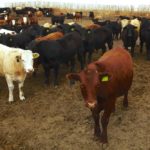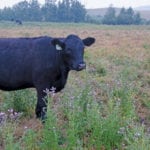Alberta fed cattle prices have dropped nearly $15 over the past three weeks. Feedlot margins are deep in red ink, with losses amounting to $200-250 per head. Compared to last week, yearlings and calves over 700 lbs. traded $3-$5 lower; calves under 700 lbs. were down $5-$8 with some feeder markets in Alberta dropping as […] Read more

Klassen: Feeder cattle succumb to negative margins

Klassen: Feeder market easily absorbs adverse weather
Western Canadian feeder markets were relatively unchanged from week-ago levels but there were a couple of unique characteristics in certain regions. Quality yearling packages were $2-$4 higher in Alberta but fleshier replacements were discounted. Eastern Prairie regions had grass cattle under 600 lbs. trading $3 to as much as $8 above week-ago levels. Order buyers […] Read more

Klassen: Fed cattle market lifts feeder prices
Compared to last week, western Canadian feeder cattle markets traded $4 on either side of unchanged. Early in the week, the market was rather sluggish but a fortuitous bounce in the live cattle futures quickly spilled over into the feeder complex. Yearlings and heavier calves ended the week $2 to $4 higher. Feeding margins are […] Read more

Klassen: Feeder market starts year with cautious tone
Western Canadian feeder cattle prices were relatively unchanged to slightly softer compared to mid-December. The market was lightly tested, with direct off farm to feedlot trade, but auction market activity was rather quiet. Winter conditions in southern Alberta caused buyers to be on the defensive, with lighter calves reflecting small discounts; however, vaccinated feeders on […] Read more

U.S. livestock: Cattle jump to contract highs
Chicago | Reuters — U.S. cattle futures climbed to life-of-contract highs on Thursday as a storm brought blizzard-like conditions to much of the Plains cattle belt, stoking expectations of higher prices for the animals in cash markets, traders said. Heavy snow could impede transportation of cattle to market in Nebraska, Kansas, Oklahoma and elsewhere while […] Read more

Klassen: Feeder market ends year on firm tone
Compared to last week, western Canadian feeder markets traded $3-$5 higher. Auction barns in the major feeding regions of Alberta had limited numbers on offer last week; therefore, major operations were sourcing feeders from farther distances. While most feedlots are carrying sufficient numbers, year-end buying was able set the market on a firm tone. April […] Read more

Klassen: Feeder market bounces off recent lows
Compared to last week, yearlings traded $5 to as much as $10 higher while calf markets strengthened by $4-$8. Southern Alberta experienced winds of extreme nature over the past few weeks, which caused buyers to shy away from the market; however, with year-end right around the corner, pent-up demand stepped forward with a vengeance in […] Read more

Klassen: Feeder market experiences softer demand
Compared to last week, western Canadian feeder cattle sold $4-$6 lower on average. Feedlot operators backed away from the markets due to stronger feed grain prices and weakness south of the border. Certain regions of the U.S. Midwest and southern Plains have experienced adverse weather, which caused U.S. feeder cattle prices to experience a week-over-week […] Read more

Klassen: Softer demand causes feeder prices to weaken
Compared to last week, Alberta feeder cattle markets traded $4 to as much as $8 lower; however, Manitoba and Saskatchewan prices experienced a week-over-week decline of $3 to $5 on average. Demand from Eastern Canada appeared to limit slippage in the eastern Prairie regions but some of these markets also faltered late in the week. […] Read more

It’s strange times in cattle markets – and normal seems a long ways off
Prices, feeder cattle movement, and the basis are all behaving strangely this year, says analyst
Reading Time: 4 minutes If you’re confused about the cattle market, you’re not alone — it is not behaving normally. “We’ve got some interesting things going on,” said Anne Wasko, market analyst with Gateway Livestock. “Over the last six to eight months, we’ve had feeder cattle moving north since last fall. This year, we’ve got feeder cattle going south. […] Read more

